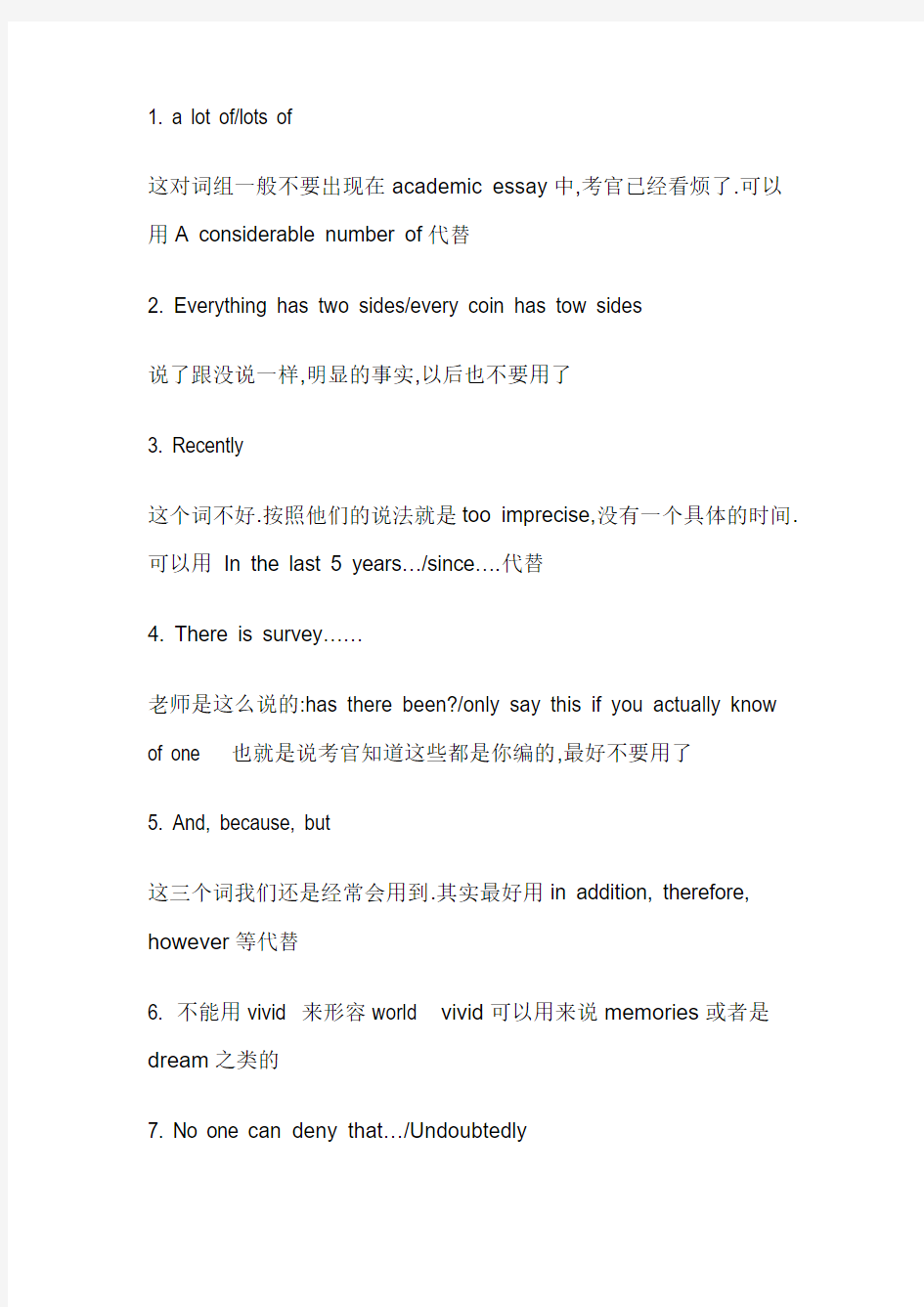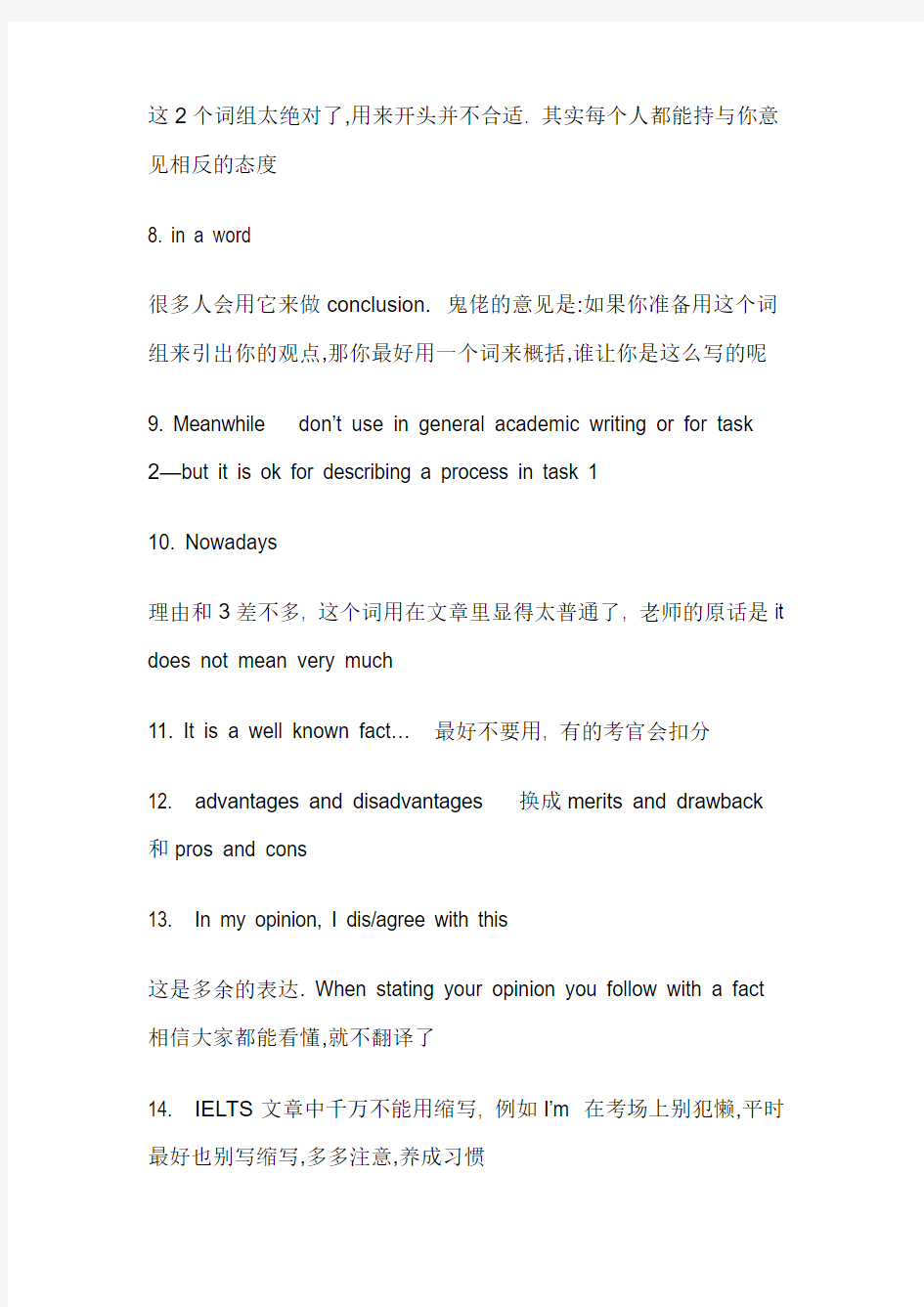雅思写作技巧指导


1. a lot of/lots of
这对词组一般不要出现在academic essay中,考官已经看烦了.可以用A considerable number of代替
2. Everything has two sides/every coin has tow sides
说了跟没说一样,明显的事实,以后也不要用了
3. Recently
这个词不好.按照他们的说法就是too imprecise,没有一个具体的时间.可以用In the last 5 years…/since….代替
4. There is survey……
老师是这么说的:has there been?/only say this if you actually know of one 也就是说考官知道这些都是你编的,最好不要用了
5. And, because, but
这三个词我们还是经常会用到.其实最好用in addition, therefore, however等代替
6. 不能用vivid 来形容world vivid可以用来说memories或者是dream之类的
7. No one can deny that…/Undoubtedly
这2个词组太绝对了,用来开头并不合适. 其实每个人都能持与你意见相反的态度
8. in a word
很多人会用它来做conclusion. 鬼佬的意见是:如果你准备用这个词组来引出你的观点,那你最好用一个词来概括,谁让你是这么写的呢9. Meanwhile don’t use in general academic writing or for task 2—but it is ok for describing a process in task 1
10. Nowadays
理由和3差不多, 这个词用在文章里显得太普通了, 老师的原话是it does not mean very much
11. It is a well known fact…最好不要用, 有的考官会扣分
12. advantages and disadvantages 换成merits and drawback 和pros and cons
13. In my opinion, I dis/agree with this
这是多余的表达. When stating your opinion you follow with a fact 相信大家都能看懂,就不翻译了
14. IELTS文章中千万不能用缩写, 例如I’m 在考场上别犯懒,平时最好也别写缩写,多多注意,养成习惯
15. very不能用来形容delicious, lovely, fantastic, wonderful, amazing, gorgeous and huge.
16. human being MS这个词指的是动物+植物, 以后可以用man kind代替
结构
When you are writing a Task 2 answer, a structure based on the following elements could be used (summarised in the flow chart opposite).
Introductory paragraph
The introduction of a Task 2 answer should begin with a general statement or idea of your own that takes into account the key topic words or their synonyms. The last sentence of the introduction should include a thesis statement which shows the point of view or direction that will be taken in the answer.
Body paragraphs
Body paragraphs each consist of several sentences that are arranged in a logical way to develop a main idea. You can expect to write about 2-4 body paragraphs for a Task 2 answer. Each of these contains an appropriate connective word to ensure a smooth transition between paragraphs. This connective is then put in a topic sentence which is the main point of the paragraph clearly stated in a sentence. Every sentence in the paragraph must be directly related to it. Try to develop every paragraph adequately. This may be done through the use of examples, explanations, detail, logical inference, cause and effect or making comparisons or contrasts. There are many different ways to organise your ideas for body paragraphs. Be confident of the ideas you choose.
The conclusion
A good conclusion serves several purposes:
?It indicates the end of your essay.
?It gives your final thoughts and assessments on the essay subject.
?It weighs up the points in your essay and should strengthen your thesis statement.
?Do not simply repeat your opening paragraph. This appears too mechanical and superficial.
小技巧
Introduction
You have one hour for the IELTS Writing test. You need to produce two pieces of writing.
Task 1 is a short report (c.150 words) using data or information given on the question paper. This information is in graphical form and could be any of the following: graphs (bar or line), pie charts, tables or process diagrams. 2 different sources may also be given. You should spend around 20 minutes on task 1.
Task 2 is an essay (c.250 words) on a given topic. There is no choice of topic, but it generally involves discussing two points of view and giving your own opinion. You should spend around 40 minutes on task 2, which has more influence on your final band score than task 1. Both tasks are discussed in detail below, but here are a few general tips:
1.Before the test:
2.Scientists and statisticians usually prefer task 1;
humanities students task 2. It is very important to
practise BOTH types of task until you are confident;
however, during the test, you could start with the type you are most familiar with. That way, if you finish it with time to spare, you have more time to spend on your least favourite. Conversely, maybe it's better to do the most
difficult first, on the grounds that you can produce the
other more easily!
3.When reading English, notice useful vocabulary and
phrases and pay attention to the grammatical structure of
sentences and the way in which sentences are linked in
longer paragraphs. Use good reading text as a model for
your own writing.
4.During the test:
https://www.360docs.net/doc/9110581315.html,e full sentences and structure yout writing into
paragraphs.Don't use ICQ or text messaging style English.
6.Spend a minute or two before you start writing to make a
basic plan or outline, especially for task 2. If you are
short of time, this stops you getting flustered and keeps
you on track as you write.
7.NB:If your text is more than 10% shorter than the number
of words required (task1=150 words, task 2=250 words),
then you will be penalised. Practise writing by hand
(maybe you haven't for a while) and count the average
number of words you write per line. That way, you know how
many lines you need to produce in the test.
Offline CILL IELTS materials for writing practice.
1.Cambridge University's Practice Exam Papers books 1,2,3.
These provide complete mock exams for self testing.
2.Cambridge University's Specimen materials folders.
3.Cambridge University's IELTS preparation course,
"Insight into IELTS" by V. Jakeman & C. McDowell
4.Preparation course "Focus on IELTS" by S. O'Connell,
Longman press
5.The British Council's "How to prepare for IELTS".
大作文
灵:大作文也是有灵魂的。
中国学生听说读写四门课写作和口语比较难拿高分,正是因为这两门考试能更为全面地反应出考生的综合语言实力,没有一定的知识面,严密的逻辑思维,熟练的思辨技巧,必然很难在较短的时间内充分展示语言的准确与丰富程度。所谓大作文的灵魂,简单地说,就是文章的内容。内容不仅包含说什么(中心句),还包含怎么说(2-3个主
题句),更包含如何自圆其说(论证的过程),以及文章的浑然一体(开头的结尾的呼应)。为了激发大家的写作思路,在该部分,严春华老师在该环节独创了一系列简洁高效的方法:“通关五穴”思路展开,“巧言善辩与融会贯通”的四大论证途径,“画龙点睛”三大高分结尾方案。保证了考生在较短的时间内快速成为作文流水线上的熟练工,生产出言之有物,见解独到的优秀作文。
动:措辞的生动到位是大作文的肉体。
中国学生普遍经历的传统的英文教学体系,注重输入能力的锻炼(阅读和听力),忽略了主动能力的培养(写作和口语),这一点导致考生在写作文时,普遍存在词汇贫乏,句型幼稚,搭配错误,时态混乱,中式英语等顽固症状。更多的同学抱着埋头苦写的态度,花了大量时间写作文,效果依然不理想,除了金钱和时间的浪费,更是被多次失败折磨到自信心受挫。事实证明,不了解中英文两种语言的差异而盲目地写作,只能将“生产”作文的过程,变成一个单纯的体力活,结果必然是事倍而功半。严春华老师在长期的教学实践中,全面细致地归纳了中文和英文的一系列差别,节省了考生自己漫漫摸索体会的时间,做到短期内迅速突破,令作文用词地道,生动传神,大大提高了文章的可读性和吸引力。“中英文差别系列观”的含金量正是在于它帮助成千上万的考生圆满地终结了英文写作的摸索过程,实现了高分与高能的双赢。
丰:措辞的丰满多变演绎出大作文的穿衣品位。
好的英语文章,除了言之有物,措辞到位,语法准确,遣词造句的丰满多变也是评分标准的重要一条。严春华老师在教学中总结了雅思真题系列里阅读和听力材料的的大量考点,建立了经典权威的同义词,反义词题库,不仅帮考生把握住阅读和听力的考试规律,各个击破地拿到高分,“VARIETY三大策略”更是革命性地实现了复习应考雅思四门时的“一石四鸟”。比如,当你能用cooperate, (cooperative spirits, boost cooperation, cooperating among different countries), collaborate, (collaborative spirits, enhance collaboration, collaborating with one another), join efforts, ( joint efforts), concerted endeavors, coordinated operation……等表达来写作的时候,当你能把剑桥阅读里的长句游刃有余地解剖归类,并将并列句,复合句,非谓语动词,倒装,排比等句法收放自如地用于大作文中,你会不知不觉地爱上了英文写作这门理性与感性有机结合,魅力与力量合二为一的精妙的文字艺术。
富:富足的语言和内容,若能再推陈出新,配以独到创意,深刻见地,和无懈可击的神来之笔,就必能以贵族气质的大家手笔,从最严格的考官手里稳操胜券。
由于东西方教育体系的重大差异,东方的学生更习惯于接受既成的知识,较少主动思维,改革创新,导致大量的考生沿袭市面上流行的范文书,如法炮制出缺乏个性,套路雷同,甚至有严重抄袭痕迹的作文;而经受过反剽窃训练的考官,很容易识别这种作文并根据抄袭程度扣
分,可惜地是,在这条道路上,依然不乏因信息不对称,而“自杀性抄袭”的前仆后继者。严春华老师的“站在巨人的肩膀上写作”“小五大六范文笔记”“高分两步走”“THINK OUTSIDE THE BOX”创意培养方案,让广大考生学会合理利用范文书这个平台,在巨人的肩膀上批判地吸收,呈现个性化的洞察力和语言魅力,不仅让成千上万的考生拿到了高分,更大大激发了考生对英语的学习激情,培养了学生们严谨创意,独立创新的良好学习习惯。严老师的教学风格独树一帜,旁征博引,幽默诙谐,生动隽永,深受学生爱戴,被暗中誉为英语“教皇”。在海派文化的上海,成就了一道“简洁高效”的教育文化风景线。(作者:严春华)
